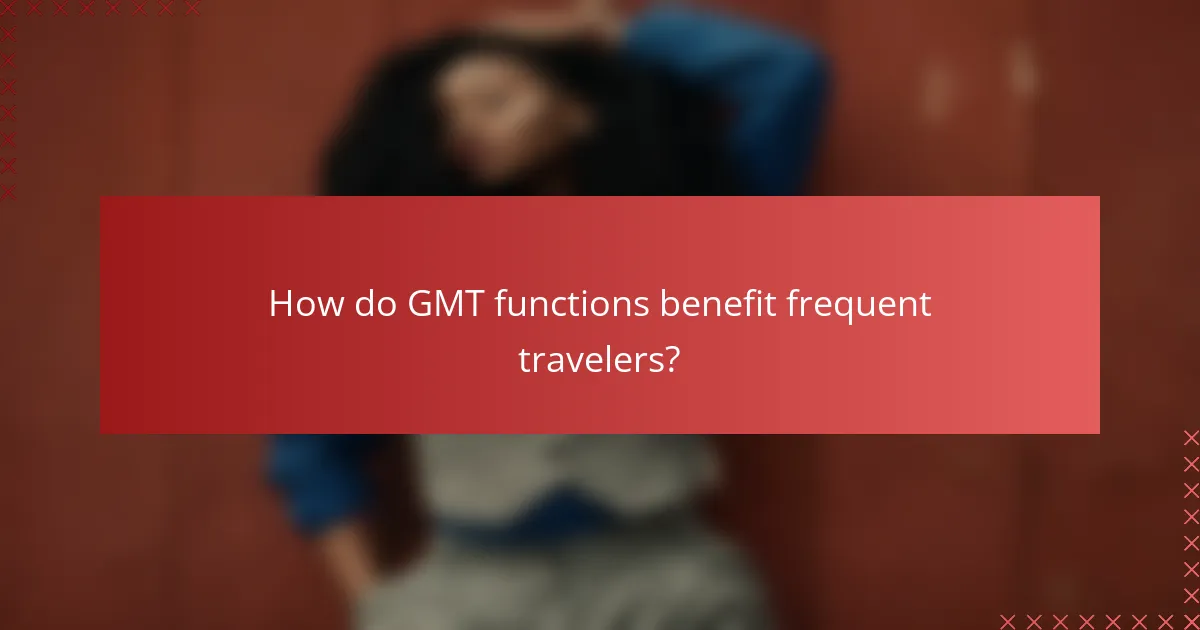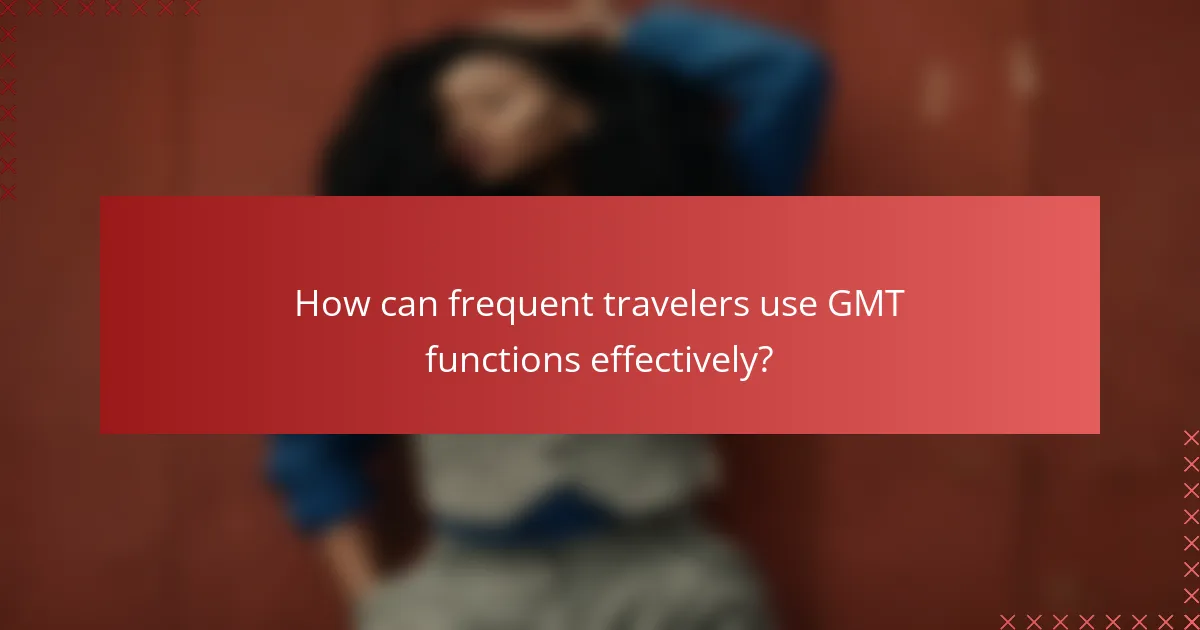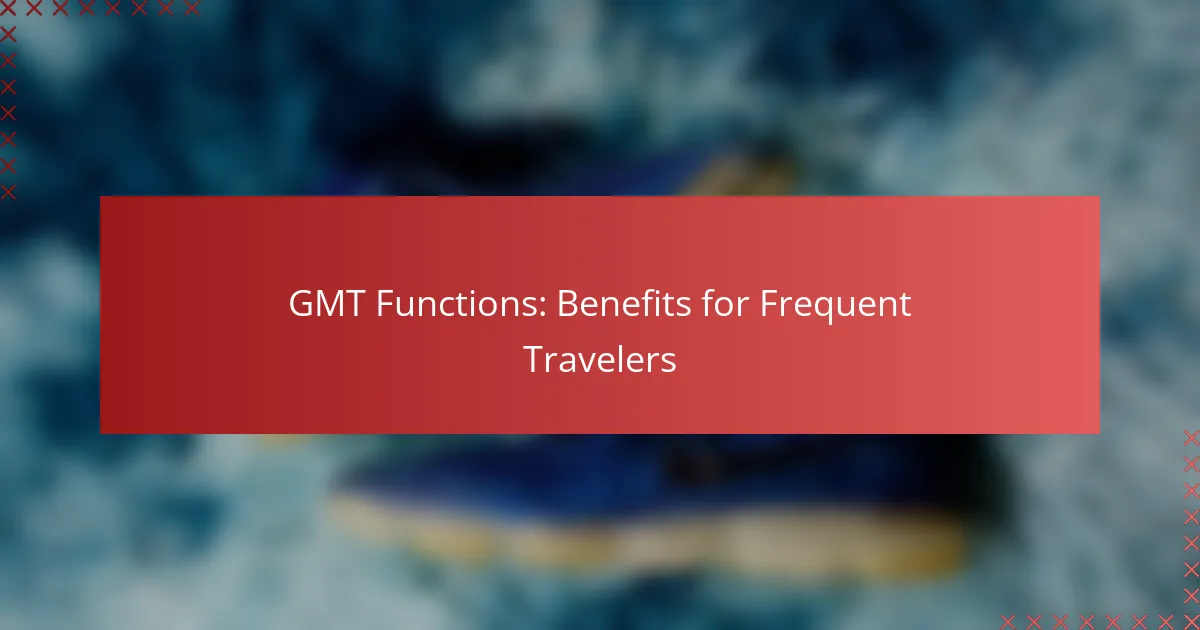GMT functions are invaluable for frequent travelers, offering essential tools to manage time differences efficiently. By leveraging these functions, travelers can streamline their schedules, enhance communication, and optimize their plans across various time zones, ensuring a smoother travel experience.

How do GMT functions benefit frequent travelers?
GMT functions provide frequent travelers with essential tools for managing time differences effectively. By utilizing these functions, travelers can streamline their schedules, enhance communication, and optimize their travel plans across various time zones.
Time zone management
Time zone management is crucial for frequent travelers to avoid confusion and missed appointments. GMT functions allow users to convert local times to their destination’s time zone easily, ensuring they are always aware of the current time wherever they are. For example, if you are in New York and need to schedule a call with someone in London, GMT functions can help you find a suitable time that works for both parties.
Many devices and applications now offer automatic time zone adjustments based on your location, which simplifies the process further. This feature helps prevent the common pitfall of forgetting to adjust your watch or device when crossing time zones.
Scheduling convenience
Scheduling convenience is significantly enhanced by GMT functions, allowing travelers to plan meetings and activities without the hassle of manual time conversions. With these functions, you can easily see overlapping hours between different time zones, making it simpler to coordinate with colleagues or friends across the globe.
Using tools that integrate GMT functions can also help you set reminders that automatically adjust to your current time zone. This ensures that you never miss an important event, regardless of where you are traveling.
Travel planning efficiency
Travel planning efficiency improves when utilizing GMT functions, as they help streamline itineraries and reduce the chances of scheduling conflicts. By knowing the exact time differences, travelers can better plan their arrival and departure times, ensuring smooth transitions between flights and accommodations.
When booking flights, consider using GMT functions to compare flight times across different airlines and routes. This can save you time and money by allowing you to select the most convenient options. Additionally, always check local time zones when making reservations for activities or transportation to avoid surprises upon arrival.

What are the best GMT functions for travelers?
The best GMT functions for travelers include tools that help manage time differences effectively, ensuring smooth communication and scheduling across various time zones. Key features like world clocks, time zone converters, and calendar integrations are essential for frequent travelers to stay organized and punctual.
World Clock feature
The World Clock feature allows travelers to view the current time in multiple locations simultaneously. This is particularly useful for scheduling calls or meetings with colleagues or friends in different time zones. Many smartphones and apps offer customizable world clocks, enabling users to add cities of interest easily.
When using a World Clock, consider setting alerts for important events in different time zones. This can help avoid confusion and ensure that you are always aware of the time differences. Some apps even allow you to compare times side by side, making it simpler to plan your day.
Time Zone Converter tools
Time Zone Converter tools are essential for converting times between different zones quickly. These tools can help travelers determine the best times for meetings or flights, taking into account the local time at their destination. Many online converters are available, as well as mobile apps that provide quick access on the go.
When using a Time Zone Converter, pay attention to daylight saving time changes, as these can affect the time difference. A reliable converter will automatically adjust for these changes, ensuring accurate results. Always double-check the converted time before making any commitments.
Calendar integration
Calendar integration allows travelers to sync their schedules across different devices and platforms, making it easier to manage appointments in various time zones. Most digital calendars, like Google Calendar or Outlook, offer features that automatically adjust event times based on the user’s location.
To maximize the benefits of calendar integration, set your primary time zone in your calendar settings and create events in the local time of the meeting or appointment. This way, you can avoid confusion and ensure that you are always on time, regardless of where you are traveling.

How can frequent travelers use GMT functions effectively?
Frequent travelers can effectively use GMT functions to manage time differences and coordinate activities across various time zones. By understanding how to set up multiple time zones, utilize mobile apps, and sync with travel itineraries, travelers can minimize confusion and enhance their travel experience.
Setting up multiple time zones
Setting up multiple time zones on your devices allows you to easily track the time in different locations. Most smartphones and computers have built-in features to add multiple time zones, which can be accessed through the settings menu. This helps you stay aware of local times while planning meetings or activities.
For example, if you frequently travel between New York and London, you can set up both time zones on your calendar app. This way, you can quickly see the time difference and avoid scheduling conflicts. Remember to adjust for daylight saving time changes, as they can affect the time difference by an hour.
Utilizing mobile apps
Mobile apps designed for time zone management can significantly simplify your travel planning. Apps like World Time Buddy or Time Zone Converter allow you to compare times across different locations and even set reminders based on local times. These tools are particularly useful when coordinating with colleagues or friends in different countries.
Additionally, many travel apps integrate GMT functions to provide real-time updates on flight schedules and local times. Make sure to download these apps before your trip and familiarize yourself with their features to maximize their effectiveness.
Syncing with travel itineraries
Syncing your calendar with travel itineraries ensures you are always aware of your schedule in relation to local times. Many airlines and travel booking platforms offer calendar integration, allowing you to automatically add flight details and layover times to your calendar.
When syncing, pay attention to the time zones listed in your itinerary. For instance, if your flight departs from Paris at 10 AM local time and arrives in New York at 1 PM local time, ensure your calendar reflects these times accurately. This practice helps prevent missed flights and ensures you arrive at meetings or events on time.

What are the prerequisites for using GMT functions?
To effectively use GMT functions, travelers need compatible devices and reliable internet access. These prerequisites ensure that users can access and utilize the features of GMT functions seamlessly during their travels.
Device compatibility
Most modern smartphones, tablets, and laptops support GMT functions, but it’s essential to check the specific software requirements. Devices should ideally run on the latest operating systems to ensure compatibility with the latest features and updates.
For example, Android devices should be running at least version 6.0, while iOS devices should be on version 12 or higher. Users should also consider whether their device has the necessary apps installed to utilize GMT functions effectively.
Internet access requirements
Reliable internet access is crucial for using GMT functions, especially for real-time updates and location tracking. Travelers should aim for a stable Wi-Fi connection or a mobile data plan that offers sufficient coverage in their destination.
Consider using local SIM cards or portable Wi-Fi devices to ensure consistent connectivity. It’s advisable to check data roaming charges and coverage maps to avoid unexpected costs while abroad.

How do GMT functions compare across different platforms?
GMT functions vary significantly across platforms, impacting how users manage time zones and scheduling. Each platform offers unique features that cater to frequent travelers, making it essential to understand their differences for effective planning.
Google Calendar vs. Apple Calendar
Google Calendar provides robust GMT functionality, allowing users to set events in different time zones easily. When creating an event, you can select a specific time zone, and the calendar will automatically adjust for daylight saving time changes.
In contrast, Apple Calendar also supports GMT functions but with a more streamlined approach. Users can set their home time zone and adjust individual events to different time zones, although it may require additional steps compared to Google Calendar.
Outlook Calendar features
Outlook Calendar offers comprehensive GMT features, including the ability to view multiple time zones side by side. This is particularly useful for scheduling meetings across different regions, as it allows users to see the time differences at a glance.
Additionally, Outlook allows users to set a primary time zone and adjust for secondary time zones, making it easier to coordinate with international contacts. However, some users may find the interface less intuitive than Google Calendar’s straightforward time zone selection.

What emerging trends are shaping GMT functions for travelers?
Emerging trends in GMT functions are increasingly focused on enhancing the travel experience through technology and personalization. Innovations such as real-time data integration, mobile applications, and AI-driven recommendations are making it easier for travelers to manage time zone differences effectively.
Integration of Real-Time Data
Real-time data integration allows travelers to access up-to-date information on time zones, flight schedules, and local events. This technology helps in adjusting plans quickly based on changes, such as flight delays or cancellations. For instance, a traveler can receive notifications about local time adjustments and optimal travel routes directly on their mobile devices.
Mobile Applications for Time Management
Mobile applications designed for time management are becoming essential tools for frequent travelers. These apps often include features like world clocks, time zone converters, and reminders that automatically adjust to the user’s location. Popular apps can help users avoid confusion when scheduling meetings across different time zones, ensuring they stay punctual.
AI-Driven Personalization
AI-driven personalization is transforming how travelers interact with GMT functions. By analyzing user preferences and travel patterns, AI can suggest optimal travel times and itineraries tailored to individual needs. For example, an AI system might recommend the best times to book flights or suggest local activities based on the traveler’s schedule and interests.
